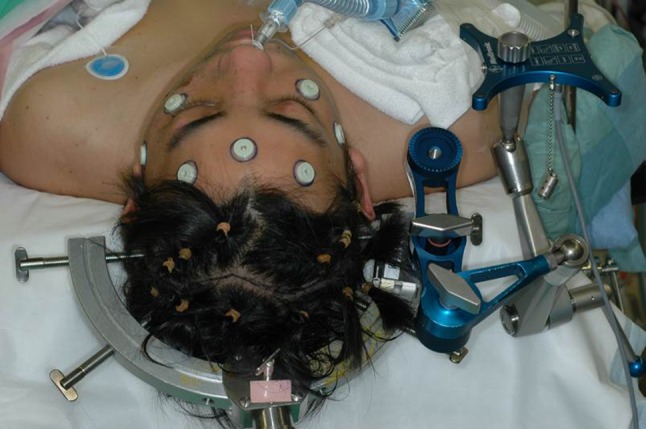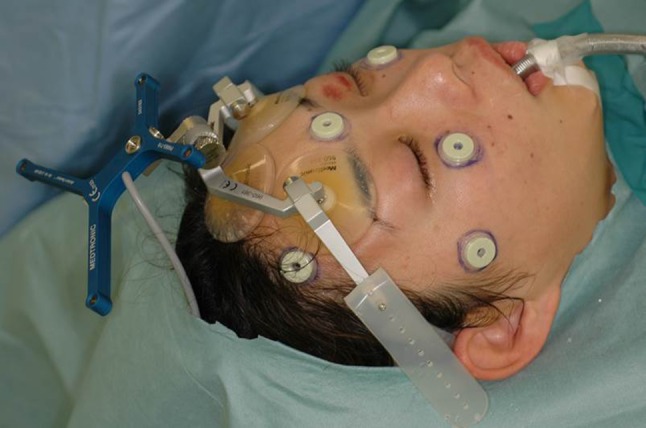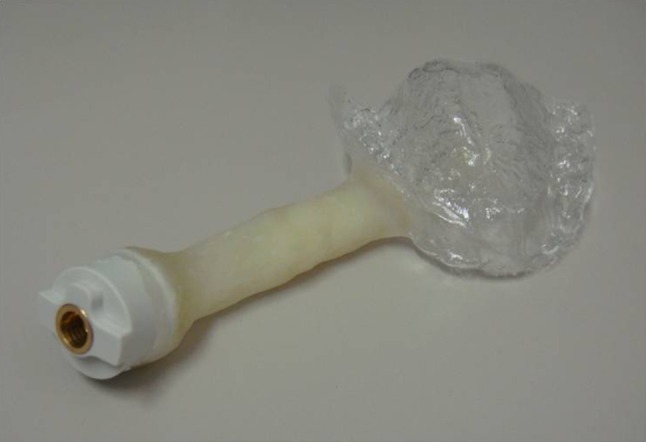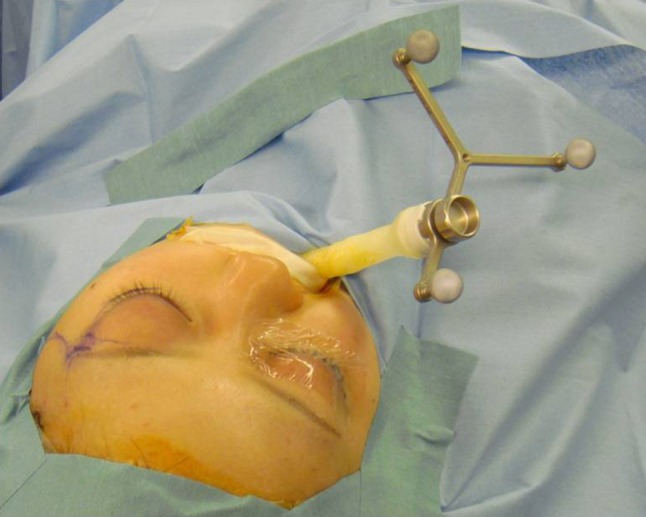Abstract
Introduction
When prepping for navigation surgery, a reference frame must be fixed to the patient’s head with a Mayfield clamp, bone anchor, headset, or headband. Fixation of the clamp or bone anchor with a screw or head pins is invasive, whereas use of a headband or headset is noninvasive. However, during orbital surgery for blowout fractures or orbital tumors, surgeons or instruments can interfere between the reference frame and the optical tracking navigation system, even if using noninvasive fixation.
Materials and methods
We used an occlusal splint for noninvasive fixation of a reference frame in orbital navigation surgery to overcome the problems.
Results
A surgeon could operate without interferences between the reference frame and the optical tracking navigation system during orbital navigation surgery.
Conclusion
We recommend the use of an occlusal splint for noninvasive fixation of a reference frame in orbital navigation surgery.
Keywords: Navigation surgery, Orbital surgery, Registration, Occlusal splint, Noninvasive fixation, Reference frame
Introduction
Recently, optical tracking navigation has been applied to oral and maxillofacial surgery [1–3]. When prepping for navigation surgery, a reference frame must be fixed to the patient’s head with a Mayfield clamp, bone anchor, headset, or headband [2, 3]. Fixation of the clamp or bone anchor with a screw or head pins is invasive (Fig. 1), whereas use of a headband or headset is noninvasive (Fig. 2). However, during orbital surgery for blowout fractures or orbital tumors, surgeons or instruments can interfere between the reference frame and the optical tracking navigation system, even if using noninvasive fixation. Surgeons sometimes contact the reference frame and re-registration is required. Because a noninvasive method without the interference can improve the surgeon’s frustration and patient’s quality of life, we report the use of an occlusal splint for noninvasive fixation of a reference frame in orbital navigation surgery.
Fig. 1.

Fixation of a reference frame to the patient’s head with a Mayfield clamp
Fig. 2.

Fixation of a reference frame to the patient’s head with a head band
Methods
Preoperatively, an occlusal splint is manufactured and a resin handle with a connector to fix the reference frame is attached to the splint (Fig. 3). We used a Kolibri navigation system (Brainlab AG, Feldkirchen, Germany) and transferred preoperative CT-based planning data to the navigation system. After tracheal intubation in the operating room, the occlusal splint is set in the dental arch and the reference frame is fixed to the handle (Fig. 4). And then registration such as point-based registration or laser surface registration is performed to correlate the reference position of a virtual 3D dataset gathered by CT imaging with the reference position of the patient. A surgeon can operate without interferences between the reference frame and the optical tracking navigation system during orbital navigation surgery.
Fig. 3.

A resin handle with a connector to fix the reference frame is attached to the occlusal splint
Fig. 4.

After tracheal intubation, the occlusal splint is set in the dental arch and the reference frame is fixed to the connector of the handle
Discussion
Because orbital surgery has technical difficulty of limited incision and view, risk of vital soft tissue injury, symmetrical orbital reconstruction after orbital fracture and orbital decompression for Graves’ orbitopathy, a navigation system has been applied in orbital surgery. In orbital navigation surgery, noninvasive fixation of the reference frame has not been used for surgical difficulty caused by a headset or reference frame with headband on the forehead and interference between the reference frame and the optical navigation system, rather the reference frame has been fixed to the patient’s head with invasive methods. Even if a reference frame was fixed to the head with a Mayfield clamp, headset, headband, or bone anchor in orbital navigational surgery, surgeons commonly must pay attention for contact to a reference frame and interference between the frame and navigation system.
Because occlusal splints with registration markers have been used for point-based registration in oral and maxillofacial surgery [1], we used an occlusal splint with a resin handle with a connector to fix the reference frame, which reduces surgical stress for surgeons. Furthermore, navigation surgery can continue because the occlusal splint is fixed to the dental arch rigidly, even if temporary removal of the occlusal splint is required during concurrent midface surgery. Therefore, we recommend use of an occlusal splint for noninvasive fixation of the reference frame in orbital navigation surgery.
References
- 1.Nijmeh AD, Goodger NM, Hawkes D, Edwards PJ, McGurk M. Image-guided navigation in oral and maxillofacial surgery. Br J Oral Maxillofac Surg. 2005;43:294–302. doi: 10.1016/j.bjoms.2004.11.018. [DOI] [PubMed] [Google Scholar]
- 2.Iwai T, Matsui Y, Hirota M, Tohnai I, Maegawa J. Temporary alopecia caused by pressure from a headband used to secure a reference frame to the head during navigational surgery. Br J Oral Maxillofac Surg. 2009;47:573–574. doi: 10.1016/j.bjoms.2009.02.019. [DOI] [PubMed] [Google Scholar]
- 3.Hohlweg-Majert B, Schön R, Schmelzeisen R, Gellrich NC, Schramm A. Navigational maxillofacial surgery using virtual models. World J Surg. 2005;29:1530–1538. doi: 10.1007/s00268-005-0091-0. [DOI] [PubMed] [Google Scholar]


